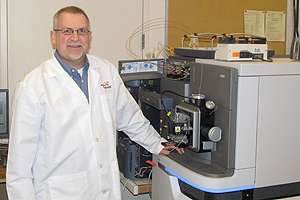Mass spectrometry provides more accurate picture of cells at work

(Phys.org) —Scientists are gaining valuable new insights into the basic processes of cells thanks to research at the University of Cincinnati.
UC Chemistry Professor and Ohio Eminent Scholar Patrick Limbach will present his research—"New Mass Spectrometry Assays for Identifying and Characterizing Modified RNAs"—at the American Chemical Society (ACS) national meeting in Dallas March 16-20.
Limbach's research group—made up of 18 post doctorates, graduate students and undergraduate researchers—seek to better understand the biochemical processes that occur in cells and, more specifically, the synthesis of proteins in the cell by unlocking the secrets within ribonucleic acid or RNA.
"From a health perspective, many diseases can arise or result from the dysfunction of protein synthesis," said Limbach. "So understanding what a healthy cell's process is versus an unhealthy cell is very important."
The bulk of his work, and the subject of his talk at ACS, involves the use of mass spectrometry—a technique that identifies compounds based on the elemental composition of the molecules and their charge state—to identify modifications to RNA.
Scientists understand that the role of RNA in the cell is to mediate between deoxyribonucleic acid (DNA) and the ribosomes that make proteins, but they know little about why RNA is modified along the way. And that is where Limbach's team and their novel mass spectrometry methods come in.
"Our primary interest is to develop new technologies that can identify when RNA structures have been modified," said Limbach. "If we can do that, then we can work with others to understand the functional implications of those changes."
Limbach points out that their mass spectrometry instrumentation can identify the more than 115 known types of modifications of RNA, but the ultimate goal will be to determine why those changes occur.
"I expect in the next five to seven years, we'll be able to take RNA from any individual and understand enough to know whether the RNA modification pattern is significant for the health of the individual," he said.
Limbach views his lab's role as that of a catalyst for basic science because of their focus on studying complex mixtures of biological RNAs.
"There are not a lot of people in the world that do RNA mass spectrometry," he said. "I think we are the only group right now that really focuses on this idea of parallel analysis of RNAs, which will enable scientists—who have been interested in the functional importance of RNA modifications but lacked the appropriate technology—an avenue to pursue these fundamental questions."
Provided by University of Cincinnati


















